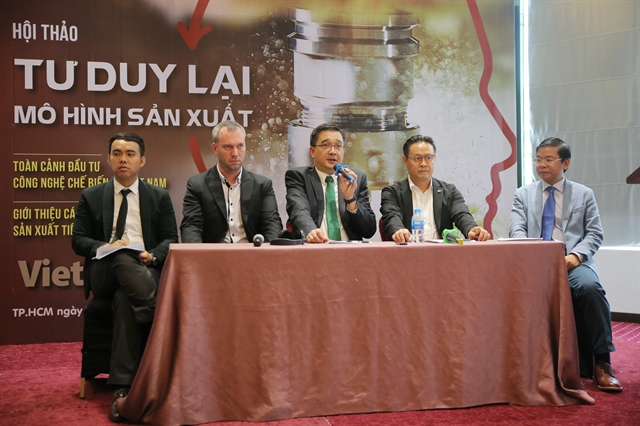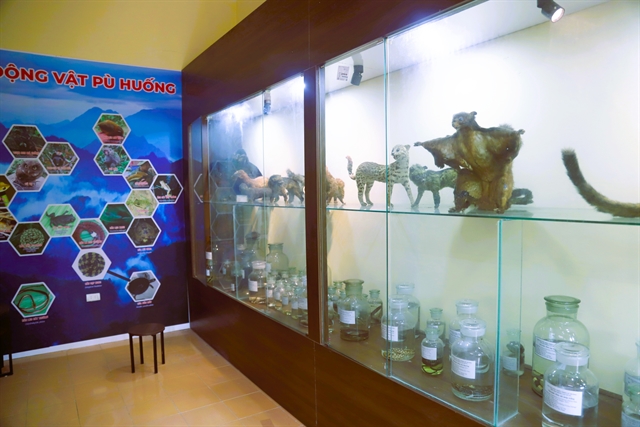 Economy
Economy


|
| A Q&A section at the “Rethinking Wood Processing Models” seminar held in HCM City on September 10. — VNS Photo |
HCM CITY — Vietnamese wood processing firms need to rethink their production models and embrace technologies to increase their competitiveness amid current and future challenges, delegates said at a seminar held in HCM City yesterday.
Nguyễn Chánh Phương, deputy chairman of the Handicrafts and Wood Industry Association of HCM City (HAWA), said the wood processing industry faced four challenges, including fierce competition in the market due to an increasing number of FDI enterprises and a fast and large shift of foreign investors coming to Việt Nam, resulting in a shortage of labourers.
In addition, it faced low labour productivity and the impact of digitalisation in the industry’ s processing, administration, design and trade.
Nguyễn Quốc Khanh, HAWA chairman, said in the first five months of the year, foreign investment capital in the country, according to the Foreign Investment Agency, was nearly 1.2 times higher than last year’s total FDI capital flowing into the country.
Of the number, there were 49 new projects investing in the wood industry (32 in wood processing), equivalent to 73 per cent of total FDI projects investing in the sector last year, he said.
This figure showed the reality of competition in the very near future. If enterprises stopped at their current capability levels, they would fail in the competition ahead.
Vietnamese wood processing enterprises, on the one hand, had to solve internal problems to ensure product quality and meet existing orders, while increasing productivity and innovation to be able to retain existing customers and get new ones. On the other hand, they must be flexible and increase their competitive advantages to stand firm and be in front for future changes, he said.
“Businesses need a serious and effective strategy. They need to have a new vision and deep thinking, in which the key to solving these two problems at the same time can only be investment in technology.
“With the advancement of CNC precision technology, combining new technologies such as artificial intelligence, big data, cloud computing, and robots, woodworking technologies have reached surprising development levels, offering businesses a lot of opportunities to improve quality, control progress, reduce dependence on labour and increase production,” Khanh said.
But when choosing technologies to invest, businesses should base their real needs and development plans in the coming years to make their investment efficient, he said.
Leslie Lye, sales manager for the Weinig Group, said with the changes in consumer buying behaviour and the availability of new technology, there has been a shift in customers’ buying requirements. Instead of buying furniture manufactured in bulk, customers are increasingly buying personalized furniture to meet their requirements. The production cost of customised furniture must be comparable to the mass-produced product.
“To fulfil market needs, furniture manufacturers need to develop a system to cater for personalized design and production management for orders with difference batches.”
Vietnamese factories have been making greater technological investments compared to other Southeast Asia countries. The investment for the 4.0 Industry era should start now or as soon as possible, he said.
“Of course, the technological investment must help solve all the urgent orders first, to match the production to the current customer’s needs, and to maximise profit as much as possible at that point of time. But in the long run, the company should foresee what technology in Industry 4.0 is offering to optimise the wood working process, so they can invest in technology wisely and correctly to obtain a consistent profit and a sustainable business.”
In addition to investment in technology, delegates at the seminar agreed that investment in qualified human resources who can understand and be able to operate this kind of equipment and technologies is also very important.
Organised by HAWA and Yorkers Trade and Marketing Services Co, the “Rethinking Wood Processing Models” seminar was a pre-event of the 13th International Woodworking Industry Fair (Vietnam Wood), which will be held in HCM City’s Saigon Exhibition and Convention Centre from September 18 to 21.
Jantin Lam from Yorkers Trade and Marketing Service Co said VietnamWood will feature more than 1,000 advanced machines and equipment of 483 exhibitors, providing an opportunity for Vietnamese firms in the sector to update technologies.
According to HAWA, Việt Nam’s import of wood processing machinery and equipment increased from US$220 million in 2017 to $280 million last year. The figure is expected to rise by 25 per cent this year.
The country’s wood product export revenue was $9 billion from last year and is targeted to reach $11 billion this year. — VNS




